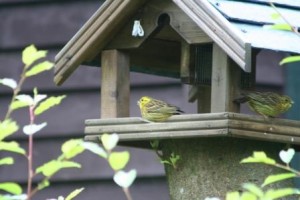Little bit of bread and no cheese
This phrase perfectly sums up the song of the yellowhammer: a quick string of five to eight notes, ending with a much longer note.
Bird guides often come up with tenuous descriptions for the songs of each species, but this is one description that hits the nail on the head.
Yellowhammers are mainly birds of farmland, often found along woodland edges. As well as their distinctive call, the males in particular are also striking in looks, especially during summer.
I’ve cheated a bit and used this picture taken by Scott of a bird table not on the reserve, but it shows the difference between males and females or juveniles.

The males are canary yellow on their heads and a slightly duller yellow on their chest and stomach. This base coat of yellow is then streaked with brown and red.
As with most bird species, the females and juveniles are much duller, lacking the bright colour, but maintaining a slightly yellow underside. This gives them a much streakier appearance, as if they have been painted by an impatient artist, using quick brush strokes to decorate them.
Listen out for the distinctive call of the yellowhammer next time you’re near farmland. On the reserve they are must often seen or heard in the meadow along the blue path.
Bye for now,
Rhian – Seasonal Ranger
Help protect Scotland’s wildlife
Our work to save Scotland’s wildlife is made possible thanks to the generosity of our members and supporters.
Join today from just £3 a month to help protect the species you love.
Preface
This phrase perfectly sums up the song of the yellowhammer: a quick string of five to eight notes, ending with a much longer note. Bird guides often come up with …
